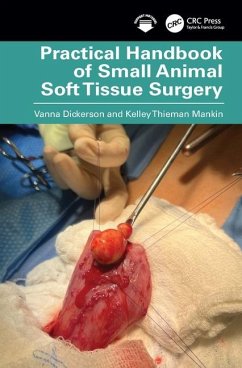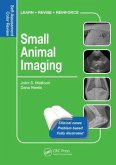- Broschiertes Buch
- Merkliste
- Auf die Merkliste
- Bewerten Bewerten
- Teilen
- Produkt teilen
- Produkterinnerung
- Produkterinnerung
This concise, image-heavy text provides a step-by-step guide to perform common surgical procedures encountered in small animal practice. A resource for busy practitioners and veterinary students, it offers a â how toâ with tips and tricks. Surgical procedures are broken down into steps, including suggested suture materials and patterns.
Andere Kunden interessierten sich auch für
![Case Studies in Small Animal Point of Care Ultrasound Case Studies in Small Animal Point of Care Ultrasound]() Case Studies in Small Animal Point of Care Ultrasound127,99 €
Case Studies in Small Animal Point of Care Ultrasound127,99 €![The Veterinary General Practice Casebook The Veterinary General Practice Casebook]() The Veterinary General Practice Casebook91,99 €
The Veterinary General Practice Casebook91,99 €![Pocket Handbook of Small Animal Medicine Pocket Handbook of Small Animal Medicine]() Kit Sturgess (Vet Freedom Ltd, Hampshire, UK)Pocket Handbook of Small Animal Medicine77,99 €
Kit Sturgess (Vet Freedom Ltd, Hampshire, UK)Pocket Handbook of Small Animal Medicine77,99 €![Small Animal Imaging Small Animal Imaging]() John S. Mattoon (College of Veterin Adjunct Professor of RadiologySmall Animal Imaging64,99 €
John S. Mattoon (College of Veterin Adjunct Professor of RadiologySmall Animal Imaging64,99 €![Practical Cardiology for Veterinary Nurses Practical Cardiology for Veterinary Nurses]() Charlotte Pace (Royal Veterinary College)Practical Cardiology for Veterinary Nurses69,99 €
Charlotte Pace (Royal Veterinary College)Practical Cardiology for Veterinary Nurses69,99 €![Skin Diseases of the Dog and Cat Skin Diseases of the Dog and Cat]() Nicole A. HeinrichSkin Diseases of the Dog and Cat73,99 €
Nicole A. HeinrichSkin Diseases of the Dog and Cat73,99 €![Animal Welfare Science Animal Welfare Science]() Emily Patterson-KaneAnimal Welfare Science110,99 €
Emily Patterson-KaneAnimal Welfare Science110,99 €-
-
-
This concise, image-heavy text provides a step-by-step guide to perform common surgical procedures encountered in small animal practice. A resource for busy practitioners and veterinary students, it offers a â how toâ with tips and tricks. Surgical procedures are broken down into steps, including suggested suture materials and patterns.
Produktdetails
- Produktdetails
- Verlag: Taylor & Francis Ltd
- Seitenzahl: 208
- Erscheinungstermin: 20. Mai 2025
- Englisch
- Abmessung: 237mm x 166mm x 18mm
- Gewicht: 382g
- ISBN-13: 9781032489629
- ISBN-10: 1032489626
- Artikelnr.: 72211331
- Herstellerkennzeichnung
- Libri GmbH
- Europaallee 1
- 36244 Bad Hersfeld
- gpsr@libri.de
- Verlag: Taylor & Francis Ltd
- Seitenzahl: 208
- Erscheinungstermin: 20. Mai 2025
- Englisch
- Abmessung: 237mm x 166mm x 18mm
- Gewicht: 382g
- ISBN-13: 9781032489629
- ISBN-10: 1032489626
- Artikelnr.: 72211331
- Herstellerkennzeichnung
- Libri GmbH
- Europaallee 1
- 36244 Bad Hersfeld
- gpsr@libri.de
Vanna Dickerson is originally from Georgia, where she began her veterinary career working as an assistant at a local general practice for nearly a decade. After completing her undergraduate studies at the University of North Georgia, she completed her DVM at the University of Georgia College of Veterinary Medicine followed by a small animal rotating internship at Friendship Hospital for Animals in Washington, DC. After her internship she returned to the University of Georgia for a research fellowship and small animal surgical residency, where her passion for all things soft tissue surgery blossomed! She is currently an assistant professor of small animal soft tissue and minimally invasive surgery at Texas A&M University Veterinary Medical Teaching Hospital, where she has worked since completing residency in 2019. She enjoys spending time with her clowder of cats, dog, and her daughter. Kelley Thieman Mankin grew up in Michigan, where she developed a love of animals and a desire to care for them. After completing her undergraduate studies and DVM at the University of Missouri, she completed a small animal rotating internship at the University of Tennessee. After her internship, she completed a combined residency and master's program at the University of Florida. During her residency, she realized her love of soft tissue surgery. She currently works with Dr. Dickerson as an associate professor of small animal soft tissue and minimally invasive surgery at Texas A&M University.
Approaches and Instrumentation. Chapter 1: Standard Instrumentation for
Soft Tissue Surgery. Chapter 2: Exploratory Laparotomy Approaches.
Gastrointestinal Surgery. Chapter 3: Gastrotomy. Chapter 4: Gastropexy.
Chapter 5: Gastric Dilatation and Volvulus. Chapter 6: Enterotomy. Chapter
7: Linear Foreign Bodies. Chapter 8: Intestinal Resection and Anastomosis.
Chapter 9: Intussusception. Chapter 10: Rectal Prolapse. Chapter 11: Small
Intestinal Biopsy. Other Abdominal Procedures. Chapter 12: Liver Biopsy.
Chapter 13: Splenectomy. Urogenital Surgery. Chapter 14: Cystotomy. Chapter
15: Retropulsion of Urethral Stones. Chapter 16:
Ovariohysterectomy/Ovariectomy. Chapter 17: Pyometra. Chapter 18: Cesarean
Section. Chapter 19: Canine Neuter. Chapter 20: Neuter with Scrotal
Ablation. Chapter 21: Cryptorchid Neuter. Chapter 22: Perineal
Urethrostomy. Chapter 23: Scrotal Urethrostomy. Chapter 24: Nephrectomy.
Amputations. Chapter 25: Thoracic Limb Amputation. Chapter 26: Pelvic Limb
Amputation. Chapter 27: Digit Amputation. Chapter 28: Tail Amputation.
Hernias. Chapter 29: Umbilical Hernias. Chapter 30: Diaphragmatic Hernias.
Chapter 31: Inguinal Hernias. Skin. Chapter 32: Principles of
Skin/Subcutaneous Mass Removals. Chapter 33: Tie-Over Bandage Placement.
References.
Soft Tissue Surgery. Chapter 2: Exploratory Laparotomy Approaches.
Gastrointestinal Surgery. Chapter 3: Gastrotomy. Chapter 4: Gastropexy.
Chapter 5: Gastric Dilatation and Volvulus. Chapter 6: Enterotomy. Chapter
7: Linear Foreign Bodies. Chapter 8: Intestinal Resection and Anastomosis.
Chapter 9: Intussusception. Chapter 10: Rectal Prolapse. Chapter 11: Small
Intestinal Biopsy. Other Abdominal Procedures. Chapter 12: Liver Biopsy.
Chapter 13: Splenectomy. Urogenital Surgery. Chapter 14: Cystotomy. Chapter
15: Retropulsion of Urethral Stones. Chapter 16:
Ovariohysterectomy/Ovariectomy. Chapter 17: Pyometra. Chapter 18: Cesarean
Section. Chapter 19: Canine Neuter. Chapter 20: Neuter with Scrotal
Ablation. Chapter 21: Cryptorchid Neuter. Chapter 22: Perineal
Urethrostomy. Chapter 23: Scrotal Urethrostomy. Chapter 24: Nephrectomy.
Amputations. Chapter 25: Thoracic Limb Amputation. Chapter 26: Pelvic Limb
Amputation. Chapter 27: Digit Amputation. Chapter 28: Tail Amputation.
Hernias. Chapter 29: Umbilical Hernias. Chapter 30: Diaphragmatic Hernias.
Chapter 31: Inguinal Hernias. Skin. Chapter 32: Principles of
Skin/Subcutaneous Mass Removals. Chapter 33: Tie-Over Bandage Placement.
References.
Approaches and Instrumentation. Chapter 1: Standard Instrumentation for
Soft Tissue Surgery. Chapter 2: Exploratory Laparotomy Approaches.
Gastrointestinal Surgery. Chapter 3: Gastrotomy. Chapter 4: Gastropexy.
Chapter 5: Gastric Dilatation and Volvulus. Chapter 6: Enterotomy. Chapter
7: Linear Foreign Bodies. Chapter 8: Intestinal Resection and Anastomosis.
Chapter 9: Intussusception. Chapter 10: Rectal Prolapse. Chapter 11: Small
Intestinal Biopsy. Other Abdominal Procedures. Chapter 12: Liver Biopsy.
Chapter 13: Splenectomy. Urogenital Surgery. Chapter 14: Cystotomy. Chapter
15: Retropulsion of Urethral Stones. Chapter 16:
Ovariohysterectomy/Ovariectomy. Chapter 17: Pyometra. Chapter 18: Cesarean
Section. Chapter 19: Canine Neuter. Chapter 20: Neuter with Scrotal
Ablation. Chapter 21: Cryptorchid Neuter. Chapter 22: Perineal
Urethrostomy. Chapter 23: Scrotal Urethrostomy. Chapter 24: Nephrectomy.
Amputations. Chapter 25: Thoracic Limb Amputation. Chapter 26: Pelvic Limb
Amputation. Chapter 27: Digit Amputation. Chapter 28: Tail Amputation.
Hernias. Chapter 29: Umbilical Hernias. Chapter 30: Diaphragmatic Hernias.
Chapter 31: Inguinal Hernias. Skin. Chapter 32: Principles of
Skin/Subcutaneous Mass Removals. Chapter 33: Tie-Over Bandage Placement.
References.
Soft Tissue Surgery. Chapter 2: Exploratory Laparotomy Approaches.
Gastrointestinal Surgery. Chapter 3: Gastrotomy. Chapter 4: Gastropexy.
Chapter 5: Gastric Dilatation and Volvulus. Chapter 6: Enterotomy. Chapter
7: Linear Foreign Bodies. Chapter 8: Intestinal Resection and Anastomosis.
Chapter 9: Intussusception. Chapter 10: Rectal Prolapse. Chapter 11: Small
Intestinal Biopsy. Other Abdominal Procedures. Chapter 12: Liver Biopsy.
Chapter 13: Splenectomy. Urogenital Surgery. Chapter 14: Cystotomy. Chapter
15: Retropulsion of Urethral Stones. Chapter 16:
Ovariohysterectomy/Ovariectomy. Chapter 17: Pyometra. Chapter 18: Cesarean
Section. Chapter 19: Canine Neuter. Chapter 20: Neuter with Scrotal
Ablation. Chapter 21: Cryptorchid Neuter. Chapter 22: Perineal
Urethrostomy. Chapter 23: Scrotal Urethrostomy. Chapter 24: Nephrectomy.
Amputations. Chapter 25: Thoracic Limb Amputation. Chapter 26: Pelvic Limb
Amputation. Chapter 27: Digit Amputation. Chapter 28: Tail Amputation.
Hernias. Chapter 29: Umbilical Hernias. Chapter 30: Diaphragmatic Hernias.
Chapter 31: Inguinal Hernias. Skin. Chapter 32: Principles of
Skin/Subcutaneous Mass Removals. Chapter 33: Tie-Over Bandage Placement.
References.








